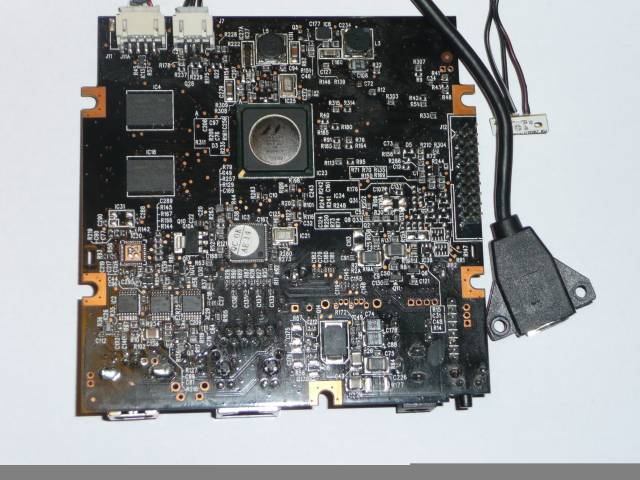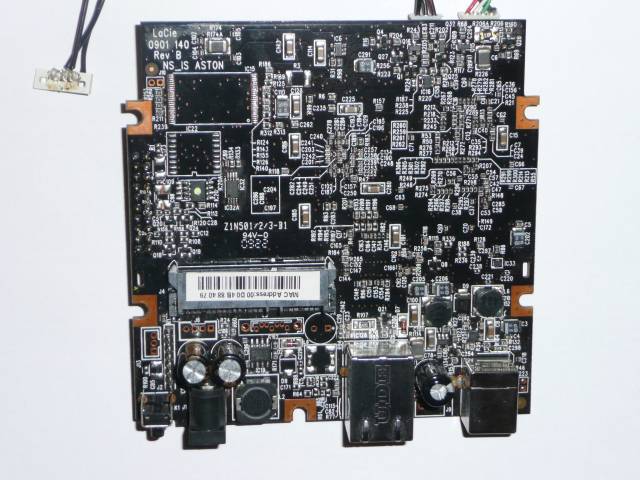This is an old revision of the document!
Table of Contents
LaCie Network Space v2
This page is relevant for Network Space (Max) v2 and Internet Space v2 boards.
Since mid-2011 lacie change the hardware configuration of the network space v2 to a lower one, see LaCie Network Space Lite v2.
Hardware
- CPU ARM926EJ-S (ARMv5TE) 800MHz
- SoC Kirkwood 88F6281_A0
- SDRAM memory 256MB, DDR2 267MHz
- SPI flash, NOR 512kB (MACRONIX MX25L4005CMI-12G)
- Ethernet Gigabit port (PHY MARVELL 88E1116R)
- 1 USB2 port, 1 connector host and 1 connector device (except for Internet Space v2)
- 1 SATA port (2 ports for Network Space Max v2)
- I2C EEPROM, 512 bytes (24C04 type)
- 2 LEDs (blue and red with CPLD SATA activity blink)
- Power push button
Openocd
An unreliable configuration is available here
U-Boot
The boards are almost fully supported mainline. For more informations, see our U-Boot for Kirkwood page.
These are the default environment variables in the stock U-Boot provided by Lacie:
baudrate=115200
loads_echo=0
rootpath=/mnt/ARM_FS/
netmask=255.255.255.0
console=console=ttyS0,115200 mtdparts=spi_flash:0x80000@0(uboot)ro,0x300000@0x100000(root)
CASset=min
MALLOC_len=1
ethprime=egiga0
bootargs_root=root=/dev/nfs rw
bootargs_end=:::DB88FXX81:eth0:none
image_name=uImage
standalone=fsload 0x2000000 $(image_name);setenv bootargs $(console) root=/dev/mtdblock0 rw ip=$(ipaddr):$(serverip)$(bootargs_end) $(mvPhoneConfig); bootm 0x2000000;
ethmtu=1500
mvPhoneConfig=mv_phone_config=dev0:fxs,dev1:fxs
mvNetConfig=mv_net_config=(00:11:88:0f:62:81,0:1:2:3),mtu=1500
usb0Mode=host
yuk_ethaddr=00:00:00:EE:51:81
netretry=no
rcvrip=169.254.100.100
loadaddr=0x02000000
autoload=no
ethact=egiga0
stderr=serial
mainlineLinux=no
enaMonExt=no
enaCpuStream=no
enaWrAllo=no
pexMode=RC
disL2Cache=no
setL2CacheWT=yes
disL2Prefetch=yes
enaICPref=yes
enaDCPref=yes
sata_dma_mode=yes
netbsd_en=no
vxworks_en=no
disaMvPnp=no
enaAutoRecovery=yes
start_lump=lump 3
resetdisk=ide reset
bootdelay=0
boot_fail=lump
kernel_addr=0x800000
productType_env=ASTON_KW
primaryPart=6
secondaryPart=A
resetFlag_env=0
bootargs=console=ttyS0,115200 root=/dev/sda7 ro reset=0 productType=ASTON_KW
bootcmd=run disk_disk
boot_disk4=disk ${kernel_addr} 1:${primaryPart}; setenv rootfs /dev/sdb7;
boot_disk3=if disk ${kernel_addr} 0:${primaryPart}; then setenv rootfs /dev/sda7; else run boot_disk4; fi
boot_disk2=if disk ${kernel_addr} 1:${secondaryPart}; then setenv rootfs /dev/sdb7; else run boot_disk3; fi
boot_disk1=if disk ${kernel_addr} 0:${secondaryPart}; then setenv rootfs /dev/sda7; else run boot_disk2; fi
boot_disk=if test ${resetFlag_env} -eq 0; then run boot_disk1; else run boot_disk3; fi
disk_disk=run boot_disk; setenv bootargs console=ttyS0,115200 root=${rootfs} ro reset=${resetFlag_env} productType=${productType_env}; bootm ${kernel_addr};
ethaddr= #mac address
ipaddr= #NAS ip
ncip= #clunc connected ip
serverip= #clunc connected ip
stdin=nc
stdout=nc
Linux
The boards are almost fully supported mainline. For more informations, see our Linux for Kirkwood page.
Userspace
Auto power on
Normally, after applying power, you have to push the button to turn on the ns2. If you want it to switch on automatically, you have to switch a bit in the i2c eeprom. The bit is at offset 14 in the eeprom, changing it from 0 to 1 will enable auto switch on. For more details see eeprom_organization



